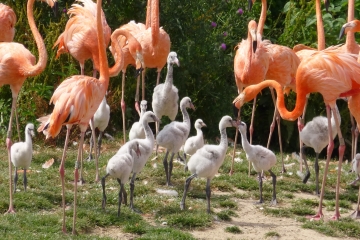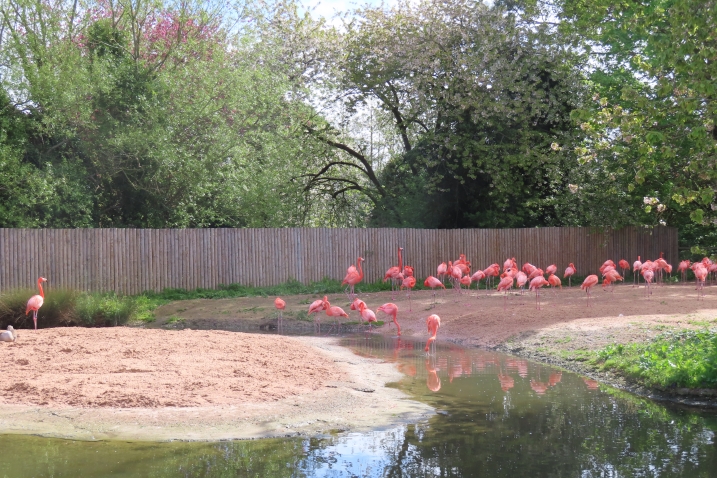Young birds of a feather like to flock together
Autumn is now upon us but this Flamingo Blog is all about flamingo chicks and the summer breeding season. Summer in the UK is when flamingos are likely to start nesting. These are, after all, birds that like to nest in areas of heat and lots of sunshine. The large flamingo flocks at WWT can produce large numbers of chicks at a time, and these bumper crops of chicks make for excellent research subjects to investigate how flamingo behaviours develop. This Flamingo Blog examines some new research from WWT that has analysed how young flamingos change their social behaviour, and how they use the habitat space around them, as they grow up into adult birds.
WWT carefully monitors breeding and nesting of the flamingos across the centres that house them to ensure populations are managed sustainably. This means that not all flocks will be nesting or producing chicks each year. Summer 2023 has been disappointing weather-wise, but it’s been great to see the greater flamingos at WWT Martin Mere producing chicks and the Chilean flamingo flock at WWT Martin Mere producing eggs too! So it’s timely to have this focus on flamingo youngsters in this post for the Flamingo Diary, as it links nicely to a newly published paper that features WWT's birds that investigated the social development of flamingo chicks as they age.

Nesting Chilean flamingos at WWT Martin Mere, and with their new arrivals. Photos courtesy of Living Collections Manager, Hannah Slaney.
Flamingos make excellent parents when their youngsters are small, grey, and fluffy; when their chick requires direct care and feeding from both of its their parents. However, as the chick grows and develops into a more “flamingo shaped and flamingo sized bird” parental care declines and the chick is left to fend for itself. Leaving the nest, growing up, and moving away from parental care is called fledging. Pretty much all species of bird do this. This is perfectly normal part of growing up and means the chick will gain important information on how to behave and where to go to be able to survive successfully as a adult. During my time as a PhD student at WWT Slimbridge, I collected data on where juvenile flamingos were in their flocks. Were they seen with adults? Were they in the edges of the social group? Were they right in the centre of the group? I had noticed that, anecdotally, the juveniles seemed to spend a lot of time together (i.e., with birds of their own age) and on the periphery (the edges) of the main flock. Together with one of my zoo biology undergraduate students, Abbie, from University Centre Sparsholt, we set about documenting and investigating these potential differences in the social choices of young flamingos compared to adults.

Juvenile greater flamingos that have fledged (left their parental care). The grey-brown colour turns to pick as they grow into adult birds.
Using data collected on the greater flamingo and Caribbean flamingo flocks at WWT Slimbridge we looked to see how a young flamingo’s choice of social partner and choice of enclosure location changed as it aged. Flamingos are quite helpful for this type of research as they go from brown to pink. We can age them by this change in plumage colour and therefore differentiate behaviour over time as they develop from chick to adult.

Where are the youngsters? Juvenile Caribbean flamingos on the edge of the group, with adults all associating together.
What we found was that younger flamingos consistently spent more time with others of a similar age, and as they grew up they integrated back more into the adult group. With sub-adult flamingos (birds of a age that were just about to become mature) being seen significantly more likely with other adults rather than with youngsters.
We also found that young flamingos do spend more time away from adults, and were more likely seen on the edges of the flock. They were not keen to be “in the thick” of the action, in the centre of the flock with all of the adults. Very young flamingos form creches - nursery groups - that keep them safe. As they move away from the colony, this behaviour of sticking together for safety seems to remain.

Caribbean flamingo creche. This creching behaviour of young chicks may be responsible for older juveniles still forming groups with similar aged birds.
Being away from the adults probably has advantages for flamingo youngsters. Adult flamingos can be aggression and push younger birds out of the best feeding areas. Adult flamingos organise a lot of their lives around reproduction and nesting. You have to be in the best, tip-top pink condition to considered a desirable partner for breeding. Young birds in their brown feathers would just get in the way. Moving to the edges of the colony, and sticking together with others of a similar age, gives the chicks a more peaceful, more relaxed environment to grow and develop into “being an adult flamingo”. And when they turn pink, and become valuable for breeding, it is easy for them to integrate back with adult birds.
The large flamingo enclosures at WWT centres give space for the youngsters to be apart from the adults, therefore they can develop naturally. We can use the findings of this type of research to check that we are providing the right environment for flamingos of all ages, and to make sure that when we do have young flamingos in our flocks, they have the opportunity to move away from the adult birds and form friendships with other flamingos of their own age.
If you’d like to know more this research, the full paper, "Age-related change in the association choices of two species of juvenile flamingos" is free to read at this link.




